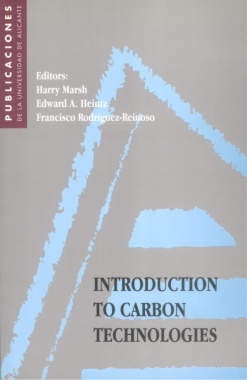Currently, the subject areas of carbon and graphite materials, their manufacture, properties and applications need to be described, comprehensively, in book format, at an up-to-date and introductory level. This book introduces the reader to such carbon materials as active carbons, carbons as catalyst supports, carbon blacks, synthetic graphites, anode carbon, carbon fibre/matrix carbon composites, as well as coal-tar pich, concluding with a Chapter setting out "limits" in emissions of discharges into the atmosphere from these industries. The book is intended for students of, e.g., materials science, engineering materials, chemistry and technology of the environment, and serves both as a text-book and as a reference book. The availability of this text allows appropriate courses to be established within our educational institutions, worldwide.
- Cover
- Title page
- Copyright page
- Preface
- Acknowledgments
- Contributors
- Contents
- Chapter 1. Carbon Materials: An Overview of Carbon Artifacts. Harry Marsh
- 1. The Earth's Formation
- 2. Carbons in Historical Perspective
- 3. Structure in Carbons
- 4. Modern Carbon Materials
- 5. Appendix-Terminologies
- 6. References
- Chapter 2. Activated Carbon: Structure, characterization, preparation and applications. Francisco Rodríguez-Reinoso
- 1. Introduction
- 2. Physical and Chemical Structure
- 3. Characterization
- 4. Effect of Porosity and Chemical Structure on Adsorptive Properties
- 5. Preparation
- 6. Applications
- 7. Markets
- 8. Areas of Future Demand
- 9. References
- Chapter 3. Carbon as a Catalyst Support: Production, properties and applications. Ljubisa R. Radovic and Chakka Sudhakar
- 1. Introduction
- 2. Fundamental Properties
- 3. Applications
- 4. References
- Chapter 4. Carbon Blacks:Production, properties and applications. Rodney Taylor
- 1. Introduction
- 2. Manufacturing Processes
- 3. Mechanism of Carbon Black Formation
- 4. Important Properties
- 5. Dispersions of Carbon Black
- 6. Carbon Black Reinforcement of Elastomers
- 7. Industrial (Non-rubber) Application
- 8. References
- Chapter 5. Carbon and Diamond Films. Wei Zhu, Sungho Jin and David J. Pickrell
- 1. Introduction
- 2. Growth Techniques
- 3. Characterization and Analysis
- 4. Conclusions
- 5. References
- Chapter 6. A History of Pitch Technologies. John W. Newman and Karen L. Newman
- 1. Introduction
- 2. Key Patents
- 3. Petroleum Derived Pitches
- 4. Pitch Markets
- 5. Toxicology
- 6. The Future of the Pitch Industries
- 7. References
- Chapter 7. Pitch Production:Supply, coking, optical microscopy and applications. Ralph J Gray and Ken C. Krupinski
- 1. Introduction
- 2. History of Coke Oven Development
- 3. Description of By-product Coke Ovens
- 4. Tar Decanters
- 5. Coking Process
- 6. Products of Coal Carbonization
- 7. Sources of Solids (QI) in Tars and Fitches
- 8. Microscopy of Tar/Pitch Solids
- 9. Coke Oven Carbons
- 10. Pitch Production
- 11. Pitch Testing - ASTM Tests
- 12. Pitch Testing - non-ASTM Tests
- 13. Transportation and Storage of Pitch
- 14. Thermal Stability of Liquid Coal-Tar Pitch
- 15. Pitch Utilization
- 16. Effects of QI on Pitch Performance
- 17. Coal-Tar Pitch Supply
- 18. Microscopy of Mesophase in Pitch
- 19. Microscopic Characterization of Electrode-Binder Pitches
- 20. Microscopy of Petroleum Cokes
- 21. References
- Chapter 8. Pitch Characterization for Industrial Applications. Maximilian Zander
- 1. Introduction
- 2. Coal-Tar Pitch
- 3. Petroleum Pitch
- 4. Analytical Characterization of Pitches
- 5. Carbonization of Pitches
- 6. Industrial Uses of Pitches in Metallurgy
- 7. Other Industrial Uses of Pitches
- 8. References
- Chapter 9. Pitch Pyrolysis Chemistry, Mesophase Chemistry and Coking. Rosa Menéndez, Marcos Granda and Jenaro Bermejo
- 1. Introduction
- 2. Chemical Characterization of Pitches
- 3. Chemistry of Pitch Pyrolysis
- 4. Mesophase Formation
- 5. Coke From Pitch and Pitch Fractions
- 6. Future Trends
- 7. References
- Chapter 10. Delayed Coking: Practice and Theory. Harry A. Adams
- 1. Introduction
- 2. What Is Coking ?
- 3. What Is Coke ?
- 4. Why Coke ?
- 5. Feed Stocks
- 6. Coking Operations
- 7. References
- Chapter 11. The Manufacture of Graphite Electrodes. Melvin B. Redmount and Edward A. Heintz
- 1. Summary
- 2. Introduction
- 3. Electrode Production
- 4. Acknowledgments
- 5. References
- Chapter 12. The Manufacture of Carbon Anodes for Aluminium Production. Harry Marsh and Karen Fiorino
- 1. Summary
- 2. Introduction
- 3. What Makes Arnold the Anode?
- 4. Arnold the Anode
- 5. Consistency and Total Control
- 6. By-Products of Other Industries
- 7. Anode Feedstocks - Petroleum Pitch Residues
- 8. Anode Feedstocks -Delayed Coke
- 9. Anode Feedstocks - Coal-Tar Pitch
- 10. Anode Feedstocks - Butt Carbon
- 11. By-Product Management
- 12. Arnold the Anode - The Perfect
- 13. Arnold the Anode -Binding/Bonding Considerations
- 14. Arnold the Anode - The Mixing Stage - Wettability
- 15. Arnold the Anode - The Imperfect
- 16. Arnold the Anode -Causes of "Blemishes" (Imperfections)
- 17. Arnold the Anode - can we help him ??
- Chapter 13. High-Density Isotropic Graphites and Glassy Carbons: Japanese situation: Production, properties and applications. Asao Oya
- 1. Introduction
- 2. High Density Isotropic Graphite
- 3. Glass-Like Carbons
- 4. Acknowledgements
- 5. References
- Chapter 14. Carbon Fiber/Carbon Composites: Production, properties and applications. Neil Murdie
- 1. Introduction
- 2. Carbon Fibers
- 3. The Relationship Between Structure and Properties of Carbon Fibers
- 4 C-C Composites
- 5. Properties of C-C Composites
- 6. Applications
- 7. References
- Chapter 15. Global Climatology and Pollution. David G. Arey and David M. Sharpe
- 1. Introduction
- 2. The Earth's Atmosphere
- 3. Ambient Air Quality and Emissions of Pollutants
- 4. Air Pollutants and Global Climate
- 5. References
- Subject index

